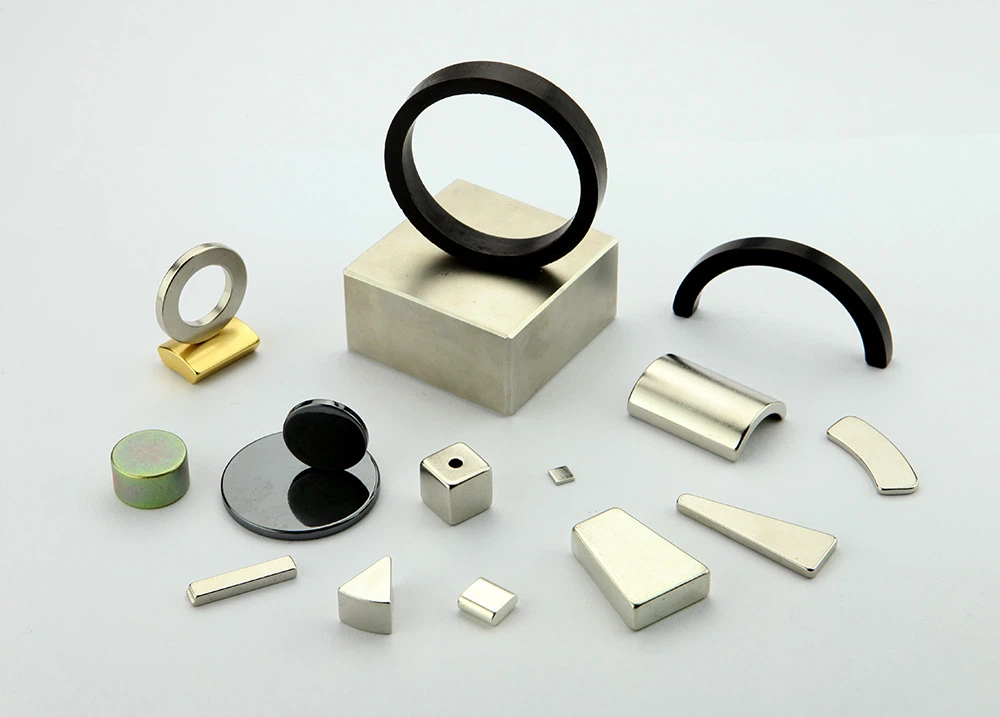NdFeB permanent magnet material is called "Magnetic King". It was discovered in 1983 and started industrialization in Japan, China, Europe and the United States in 1985. It has been 35 years since then. In the past 35 years, the global NdFeB permanent magnet material industry has developed vigorously, the magnetic properties have continuously refreshed records, the variety and grades of materials have continued to increase, industrial technology innovation has changed rapidly, and the output of materials has increased rapidly.
NdFeB permanent magnets are tetragonal crystals formed of neodymium, iron and boron. According to different production processes, they can be divided into three types: sintered NdFeB, bonded NdFeB and hot-pressed NdFeB. Due to the different production processes, They are quite different in product magnetic properties, post-processing and application.
Sintered NdFeB
Sintered NdFeB is the largest and most widely used product in the NdFeB family. It is produced by powder metallurgy. According to the coercive force of the product, it is divided into N, M, H, SH, UH, EH and TH. series. At present, the sintered NdFeB that has been commercially produced has a remanence of up to 1.45T and an intrinsic coercive force of up to 2786kA/m. The working temperature is between 80° and 200° depending on the coercive force. Sintered NdFeB is easily oxidized and corroded, so surface treatment is required. According to different environmental requirements, phosphating, electroplating, chemical plating, electrophoresis, vapor deposition and other surface treatment methods can be used. Common coatings such as zinc, nickel, Nickel copper nickel, epoxy resin, etc.

Bonded NdFeB
Sintered NdFeB is difficult to precisely process into a special shape, and it is prone to cracking, damage, and difficult assembly during the processing. In order to solve these problems, people try to crush the permanent magnet and mix it with an adhesive, and press it in a magnetic field. , Bonded NdFeB came out in this way. It has the advantages of low cost, high dimensional accuracy, large degree of freedom in shape, good mechanical strength, light specific gravity, etc., and has been widely used in the market.
There are currently four processes for forming bonded NdFeB: calendering, injection molding, extrusion and compression molding, among which calendering and injection are more mainstream. Bonded NdFeB magnets are generally only 80% of the theoretical density due to the addition of a large amount of binder, so their magnetic properties are weaker than those of sintered NdFeB magnets. Bonded NdFeB is an isotropic magnet with the same magnetism in all directions, so it is convenient to manufacture multi-pole or even infinite-pole integral magnets. (bonded NdFeB can also be made into anisotropic magnets).

Hot pressed NdFeB
Hot-pressed NdFeB can achieve magnetic properties similar to those of sintered NdFeB without adding heavy rare earth elements. It has the advantages of high density, high orientation, good corrosion resistance, and high coercive force, but its mechanical properties are not good. , and due to patent monopoly and high processing costs, only a handful of companies in the market have achieved mass production of hot-pressed NdFeB products.

Due to the limitations of molding technology, hot-pressed NdFeB can only be made into rings at present, and the application range is limited to a certain extent. At present, it is mainly used in automotive EPS motors and other fields. Hot-pressed NdFeB magnets have high magnetic properties, and the maximum magnetic energy product in the radial direction of the magnetic ring can reach 240-360kJ/m3. The magnetic ring is oriented in the radial direction, and the radial magnetic properties are uniform, which can make the motor run quietly and the torque output is smooth. At the same time, it also has high heat resistance, and the service temperature can reach 180°C-200°C.
Due to the huge difference in magnetic properties and molding, the intersection of bonded NdFeB and sintered NdFeB is not large. Bonded NdFeB is mainly used in the fields of hard disk drive spindle motors and small power micro motors. , while sintered NdFeB is more used in fields such as driving motors with higher power. Due to the limitation of shape, hot-pressed NdFeB is only used in automotive EPS.
Maximum magnetic energy | Intrinsic Coercive Force (koe) | remanence | Working temperature | Advantages and disadvantages | |
| Sintered NdFeB | 33-55 | 12-35 | 11-15 | 200℃ | Advantages: extremely high magnetic performance Disadvantages: high-grade products contain medium and heavy rare earths, high cost; high loss during processing |
| Bonded NdFeB | 6-12 | 7-18 | 6-8 | 160℃ | Advantages: flexible shape, high precision and low processing loss; does not contain heavy rare earths and low cost Disadvantages: low magnetic performance, low working temperature; patent monopoly |
| Hot pressed NdFeB | 28-473 | 10-25 | 12-14 | 200℃ | Advantages: low cost, high performance, low loss during processing Disadvantages: single shape, patent monopoly |
